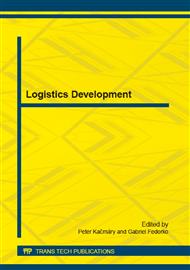[1]
R. Kampf, P. Průša, C. Savage, Systematic location of the public logistic centres in Czech Republic, Transport. 26-4 (2011) 425-432.
DOI: 10.3846/16484142.2011.635424
Google Scholar
[2]
K. Witkowski, S. Saniuk, Aspect of logistics management of the city infrastructure, Logistyka. 41-2 (2011) 589-600.
Google Scholar
[3]
L. Cooper, Heuristic Methods for Location-Allocation Problems, Operations Research. 11-3, (1964) 331-343.
Google Scholar
[4]
T. L. Saaty, How To Make a Decision, The Analytic Hierarchy Process, Interfaces. 24-6 (1994) 19-43.
DOI: 10.1287/inte.24.6.19
Google Scholar
[5]
A. G. Granberg, Curriculum of the regional economy, GU VŠE, Moscow, (2003).
Google Scholar
[6]
L.R. Foulds, Techniques for facilities layout: Deciding which pairs of activities should be adjacent, Management Science. 29-12 (1983) 1414-1426.
DOI: 10.1287/mnsc.29.12.1414
Google Scholar
[7]
M. Čambál, D. Cagáňová, J. Šujanová, The Industrial Enterprise Performance Increase through the Competency Model Application, Arcada University of Applied Science, Helsinki, Academic Publishing International. (2012) 118-126.
Google Scholar
[8]
I. Gros, J. Dyntar, S. Grosová, Food Products Distribution Systems Redesign in the Food Corporation Acquisition and Fusion Conditions, Czech Journal of Food Sciences. 27-4 (2009) 223-227.
DOI: 10.17221/80/2009-cjfs
Google Scholar
[9]
P. McCann, Industrial Location Economics, Edward Elgar Publishing Limited, Cheltenham, (2002).
Google Scholar
[10]
A. Rosová, Logistics costs of the enterprise, Acta Montanistica Slovaca. 12-2 (2007) 121-127.
Google Scholar
[11]
M. Straka, Logistics of distribution, How effectively to get product into the market, EPOS, Bratislava, 2013. (original in Slovak).
Google Scholar
[12]
P. Trebuňa, J. Halčinová, Mathematical Tools of Cluster Analysis, Applied Mathematics. 4-5, (2013) 814-816.
DOI: 10.4236/am.2013.45111
Google Scholar
[13]
P. Besta, A. Samolejová, K. Janovská, M. Lampa, R. Lenort, Evaluation of benefits resulting from innovation of input raw materials dosing process in sintering, Metalurgija. 51-4 (2012) 457-460.
Google Scholar
[14]
S. Saniuk, A. Saniuk, R. Lenort, A. Samolejova, Formation and planning of virtual production networks in metallurgical clusters, Metalurgija. 53-4 (2014) 725-727.
Google Scholar
[15]
N. Horňáková, H. Vidová, M. Beluský, Improving of Manufacturing Systems in Slovak Industrial Enterprises, Advanced Materials Research, Clausthal-Zellerfeld, Trans Tech Publications, Mechanical and Material Engineering. 774-776 (2013) 1361-1368.
DOI: 10.4028/www.scientific.net/amr.774-776.1361
Google Scholar
[16]
S. Saniuk, A. Saniuk, Rapid prototyping of constraint-based production flows in outsourcing, Advanced Materials Research, 44-46 (2008) 355-360.
DOI: 10.4028/www.scientific.net/amr.44-46.355
Google Scholar
[17]
A. Samolejová, J, Feliks, R. Lenort, P. Besta, A hybrid decision support system for iron ore supply, Metalurgija. 51-1 (2012) 91-93.
Google Scholar
[18]
M. Balog, M. Straka: Aapplication of the logistics principles for the company Omega, s. r. o. in crisis time, Acta Logistica. 1-1 (2014) 17-21.
DOI: 10.22306/al.v1i1.11
Google Scholar
[19]
L. Pepucha, L. Remek, J. Šrámek, P. Danišovič, M. Slabej, M. Grinč: Implementation of Asset Management in Road Administration of Slovak Republic, Acta Logistica, 1-1 (2014) 27-34.
DOI: 10.22306/al.v1i1.14
Google Scholar
[20]
J. Šaderová, P. Kačmáry, The simulation model as a tool for the design of number of storage locations in production buffer store, Acta Montanistica Slovaca. 18-1 (2013) 33-39.
Google Scholar
[21]
R. Winkler, Effectiveness - an attempt about conceptualization of the idea, Zeszyty Naukowe Uniwersytetu Ekonomicznego w Krakowie. 820 (2010) 105-117.
Google Scholar
[22]
P. Trebuňa, M. Kliment, M. Fiľo, J. Markovič, J. Halčinová, PLM systems, their history and application today in business process modeling, Mechanics, Scientific researches and methodical development. 7 (2013) 129-133.
Google Scholar
[23]
P. Ceniga, V. Šukalová, Status, importance and use of logistics in transport telematics, Transport means. (2013) 118-121.
Google Scholar
[24]
S. Golak, D. Burchart-Korol, K. Czaplicka-Kolarz, T. Wieczorek, Application of Neural Network for the Prediction of Eco-efficiency, Lecture Notes in Computer Science LNCS 6677. (2011) 380-387.
DOI: 10.1007/978-3-642-21111-9_43
Google Scholar
[25]
I. Leššo, P. Flegner, M. Laciak, K. Feriančiková, Hilbert spaces as an efficient instrument for signal processing in geotechnics application of vector quantisation method, Hilbert space for effective and quality process control of rock disintegration by rotary drilling, 12th International Carpatian Control Conference (ICCC2011). (2011).
DOI: 10.1109/carpathiancc.2011.5945857
Google Scholar
[26]
J. Šaderová, P. Kačmáry, Application of the simulation of a tank capacity proposal for loading and unloading process of bulk material, Acta Montanistica Slovaca. 17-3 (2012) 143-150.
Google Scholar
[27]
G. Fedorko, E. Stanova, V. Molnár, N. Husáková, S. Kmet, Computer modelling and finite element analysis of spiral triangular strands, Advances in Engineering Software. 73 (2014) 11-21.
DOI: 10.1016/j.advengsoft.2014.02.004
Google Scholar
[28]
E. Loučanová, A. Zaušková, Methodology of knowledge mapping in industrial clusters, Intercathedra, Annual scientific bulletin of plant-economic department of the European wood technology university studies. 23 (2007) 66-67.
Google Scholar


